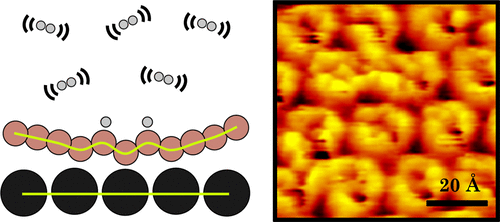Our official English website, www.x-mol.net, welcomes your
feedback! (Note: you will need to create a separate account there.)
Exciting H2 Molecules for Graphene Functionalization.
ACS Nano ( IF 15.8 ) Pub Date : 2018-01-05 00:00:00 , DOI: 10.1021/acsnano.7b07079 Line Kyhl 1 , Régis Bisson 2 , Richard Balog 3 , Michael N Groves 3 , Esben Leonhard Kolsbjerg 1 , Andrew Martin Cassidy 3 , Jakob Holm Jørgensen 1 , Susanne Halkjær 3 , Jill A Miwa 1, 3 , Antonija Grubišić Čabo 1 , Thierry Angot 2 , Philip Hofmann 3 , Mohammad Alif Arman 4 , Samuli Urpelainen 4 , Paolo Lacovig 5 , Luca Bignardi 5 , Hendrik Bluhm 6 , Jan Knudsen 4, 7 , Bjørk Hammer 1, 3 , Liv Hornekaer 1, 3
ACS Nano ( IF 15.8 ) Pub Date : 2018-01-05 00:00:00 , DOI: 10.1021/acsnano.7b07079 Line Kyhl 1 , Régis Bisson 2 , Richard Balog 3 , Michael N Groves 3 , Esben Leonhard Kolsbjerg 1 , Andrew Martin Cassidy 3 , Jakob Holm Jørgensen 1 , Susanne Halkjær 3 , Jill A Miwa 1, 3 , Antonija Grubišić Čabo 1 , Thierry Angot 2 , Philip Hofmann 3 , Mohammad Alif Arman 4 , Samuli Urpelainen 4 , Paolo Lacovig 5 , Luca Bignardi 5 , Hendrik Bluhm 6 , Jan Knudsen 4, 7 , Bjørk Hammer 1, 3 , Liv Hornekaer 1, 3
Affiliation

|
Hydrogen functionalization of graphene by exposure to vibrationally excited H2 molecules is investigated by combined scanning tunneling microscopy, high-resolution electron energy loss spectroscopy, X-ray photoelectron spectroscopy measurements, and density functional theory calculations. The measurements reveal that vibrationally excited H2 molecules dissociatively adsorb on graphene on Ir(111) resulting in nanopatterned hydrogen functionalization structures. Calculations demonstrate that the presence of the Ir surface below the graphene lowers the H2 dissociative adsorption barrier and allows for the adsorption reaction at energies well below the dissociation threshold of the H–H bond. The first reacting H2 molecule must contain considerable vibrational energy to overcome the dissociative adsorption barrier. However, this initial adsorption further activates the surface resulting in reduced barriers for dissociative adsorption of subsequent H2 molecules. This enables functionalization by H2 molecules with lower vibrational energy, yielding an avalanche effect for the hydrogenation reaction. These results provide an example of a catalytically active graphene-coated surface and additionally set the stage for a re-interpretation of previous experimental work involving elevated H2 background gas pressures in the presence of hot filaments.
中文翻译:

令人兴奋的H2分子对石墨烯的功能化作用。
通过组合扫描隧道显微镜,高分辨率电子能量损失谱,X射线光电子能谱测量和密度泛函理论计算,研究了石墨烯通过暴露于振动激发的H 2分子而得到的氢官能化。测量结果表明,振动激发的H 2分子解离吸附在Ir(111)上的石墨烯上,从而形成纳米图案的氢官能化结构。计算表明,石墨烯下方Ir表面的存在降低了H 2的离解吸附势垒,并允许在远低于H–H键的离解阈值的能量下发生吸附反应。第一个反应的H 2分子必须包含相当大的振动能才能克服离解性吸附障碍。但是,这种初始吸附进一步活化了表面,从而降低了对随后的H 2分子进行解离吸附的势垒。这使得能够通过具有较低振动能的H 2分子进行官能化,从而为氢化反应产生雪崩效应。这些结果提供了一个具有催化活性的石墨烯涂层表面的实例,并为重新解释先前的实验工作奠定了基础,该实验涉及在存在热丝的情况下涉及升高的H 2背景气体压力。
更新日期:2018-01-05
中文翻译:

令人兴奋的H2分子对石墨烯的功能化作用。
通过组合扫描隧道显微镜,高分辨率电子能量损失谱,X射线光电子能谱测量和密度泛函理论计算,研究了石墨烯通过暴露于振动激发的H 2分子而得到的氢官能化。测量结果表明,振动激发的H 2分子解离吸附在Ir(111)上的石墨烯上,从而形成纳米图案的氢官能化结构。计算表明,石墨烯下方Ir表面的存在降低了H 2的离解吸附势垒,并允许在远低于H–H键的离解阈值的能量下发生吸附反应。第一个反应的H 2分子必须包含相当大的振动能才能克服离解性吸附障碍。但是,这种初始吸附进一步活化了表面,从而降低了对随后的H 2分子进行解离吸附的势垒。这使得能够通过具有较低振动能的H 2分子进行官能化,从而为氢化反应产生雪崩效应。这些结果提供了一个具有催化活性的石墨烯涂层表面的实例,并为重新解释先前的实验工作奠定了基础,该实验涉及在存在热丝的情况下涉及升高的H 2背景气体压力。











































 京公网安备 11010802027423号
京公网安备 11010802027423号